Analysis of Extreme Cold Events of December 2022 and January 2024 in the United States
Abstract
:1. Introduction
2. Data and Methods
2.1. Data
2.2. Definition of Extreme Cold Events
2.3. Linear Regression
2.4. Empirical Orthogonal Function (EOF) Analysis
3. Results
3.1. The Manifestation of the Extreme Cold Event in NA of December 2022
3.2. The Anomaly of Atmosphere Circulation for This Extreme Cold Event
3.3. The Impact of AO on This Extreme Cold Event
3.4. The Outbreak Stage of Cold Event in January 2024
4. Discussion
5. Conclusions
Author Contributions
Funding
Institutional Review Board Statement
Informed Consent Statement
Data Availability Statement
Conflicts of Interest
References
- Hansen, B.B.; Isaksen, K.; Benestad, R.E.; Kohler, J.; Pedersen, Å.Ø.; Loe, L.E.; Coulson, S.J.; Larsen, J.O.; Varpe, Ø. Warmer and wetter winters: Characteristics and implications of an extreme weather event in the High Arctic. Environ. Res. Lett. 2014, 9, 114021. [Google Scholar] [CrossRef]
- Mingxin, L.; Yan, L.; Chunyan, L. Analysis of the characteristics and atmospheric circulation causes of two types of extreme cold events in winter in China. Plateau Meteorol 2021, 40, 603–620. (In Chinese) [Google Scholar]
- Smith, E.T.; Sheridan, S.C. The influence of extreme cold events on mortality in the United States. Sci. Total Environ. 2019, 647, 342–351. [Google Scholar] [CrossRef] [PubMed]
- Qi, Q.; Jiang, B.; Ma, W.; Marley, G. Trend analysis and spatial distribution of meteorological disaster losses in China, 2004–2015. Atmosphere 2022, 13, 208. [Google Scholar] [CrossRef]
- Meng, F.; Huang, H.; Guo, J.; Ren, G.; Zhang, J. Spatio-Temporal Characteristics of Extreme Cold Events and Their Impacts on Population and Economy in Tianjin Binhai New Area, China. Pol. J. Environ. Stud. 2023, 32, 2775–2785. [Google Scholar] [CrossRef]
- Yao, Y.; Zhuo, W.; Gong, Z.; Luo, B.; Luo, D.; Zheng, F.; Zhong, L.; Huang, F.; Ma, S.; Zhu, C. Extreme cold events in north America and Eurasia in November-December 2022: A potential vorticity gradient perspective. Adv. Atmos. Sci. 2023, 40, 953–962. [Google Scholar] [CrossRef]
- Cohen, J.; Screen, J.A.; Furtado, J.C.; Barlow, M.; Whittleston, D.; Coumou, D.; Francis, J.; Dethloff, K.; Entekhabi, D.; Overland, J.; et al. Recent Arctic amplification and extreme mid-latitude weather. Nat. Geosci. 2014, 7, 627–637. [Google Scholar] [CrossRef]
- Serreze, M.C.; Barry, R.G. Processes and impacts of Arctic amplification: A research synthesis. Glob. Planet. Change 2011, 77, 85–96. [Google Scholar] [CrossRef]
- Previdi, M.; Smith, K.L.; Polvani, L.M. Arctic amplification of climate change: A review of underlying mechanisms. Environ. Res. Lett. 2021, 16, 093003. [Google Scholar] [CrossRef]
- Vose, R.S.; Easterling, D.R.; Kunkel, K.E.; LeGrande, A.N.; Wehner, M.F.; Temperature Changes in the United States. Climate Science Special Report: Fourth National Climate Assessment 1(GSFC-E-DAA-TN49028) 2017. Available online: https://ntrs.nasa.gov/citations/20180001314 (accessed on 1 January 2024).
- Fall, S.; Diffenbaugh, N.S.; Niyogi, D.; Pielke Sr, R.A.; Rochon, G. Temperature and equivalent temperature over the United States (1979–2005). Int. J. Climatol. 2010, 30, 2045–2054. [Google Scholar] [CrossRef]
- Smith, I.A.; Fabian, M.P.; Hutyra, L.R. Urban green space and albedo impacts on surface temperature across seven United States cities. Sci. Total Environ. 2023, 857, 159663. [Google Scholar] [CrossRef]
- Marengo, J.; Espinoza, J.C.; Bettolli, L.; Cunha, A.P.; Molina-Carpio, J.; Skansi, M.; Correa, K.; Ramos, A.M.; Salinas, R.; Sierra, J.-P. A cold wave of winter 2021 in central South America: Characteristics and impacts. Clim. Dyn. 2023, 61, 2599–2621. [Google Scholar] [CrossRef] [PubMed]
- Wen, M.; Yang, S.; Kumar, A.; Zhang, P. An analysis of the large-scale climate anomalies associated with the snowstorms affecting China in January 2008. Mon. Weather Rev. 2009, 137, 1111–1131. [Google Scholar] [CrossRef]
- Lan, X.; Chen, W. Strong cold weather event over eurasia during the winter of 2011–2012 and downward AO signal from the stratosphere. In Взаимoдействие Пoлей и Излучения с Веществoм; 2013; pp. 68–69. Available online: https://www.elibrary.ru/item.asp?id=26670779 (accessed on 14 September 2023).
- Cui, H.Y.; Qiao, F.L. Analysis of the extremely cold and heavy snowfall in North America in January 2015. Atmos. Ocean. Sci. Lett. 2016, 9, 75–82. [Google Scholar] [CrossRef]
- Zhang, Z.; Cui, H.; Chen, B.; Cai, H.; Li, P. Effect of the Blocking High-East Asian Trough on three Extreme Cold Events in Eastern Asia. Adv. Atmos. Sci. 2023, 0029, R2. [Google Scholar]
- Wu, A.; Hsieh, W.W.; Shabbar, A.; Boer, G.J.; Zwiers, F.W. The nonlinear association between the Arctic Oscillation and North American winter climate. Clim. Dyn. 2006, 26, 865–879. [Google Scholar] [CrossRef]
- Wettstein, J.J.; Mearns, L.O. The influence of the North Atlantic–Arctic Oscillation on mean, variance, and extremes of temperature in the northeastern United States and Canada. J. Clim. 2002, 15, 3586–3600. [Google Scholar] [CrossRef]
- Overland, J.E.; Wang, M. The Arctic climate paradox: The recent decrease of the Arctic Oscillation. Geophys. Res. Lett. 2005, 32, 6. Available online: https://agupubs.onlinelibrary.wiley.com/doi/full/10.1029/2004GL021752 (accessed on 16 March 2024). [CrossRef]
- Kalnay, E.; Kanamitsu, M.; Kistler, R.; Collins, W.; Deaven, D.; Gandin, L.; Iredell, M.; Saha, S.; White, G.; Woollen, J.; et al. The NCEP/NCAR 40-year reanalysis project. In Renewable Energy; Routledge: London, UK, 2018; Volume 1, pp. 146–194. Available online: https://www.taylorfrancis.com/chapters/edit/10.4324/9781315793245-16/ncep-ncar-40-year-reanalysis-project-kalnay-kanamitsu-kistler-collins-deaven-gandin-iredell-saha-white-woollen-zhu-chelliah-ebisuzaki-higgins-janowiak-mo-ropelewski-wang-leetmaa-reynolds-roy-jenne-dennis-joseph (accessed on 9 July 2023).
- Leetmaa, A.; Reynolds, R.; Jenne, R.; Josepht, D. The NCEP/NCAR 40-year reanalysis project. Bull. Am. Meteor. Soc. 1996, 77, 437–471. [Google Scholar]
- Higgins, R.W.; Leetmaa, A.; Kousky, V.E. Relationships between climate variability and winter temperature extremes in the United States. J. Clim. 2002, 15, 1555–1572. [Google Scholar] [CrossRef]
- Zhang, J.; Yue, P.; Zhang, Q.; Wang, Z. Impact of tropospheric polar vortex on winter cold extremes over Northeast China. Atmos. Res. 2023, 294, 106942. [Google Scholar] [CrossRef]
- Zhang, Z.; Cui, H.; Chen, B.; Cai, H.; Li, P. The combined effects of North Atlantic Oscillation and Western Pacific teleconnection on winter temperature in Eastern Asia during 1980–2021. Acta Oceanol. Sin. 2023, 42, 1–9. [Google Scholar] [CrossRef]
- Shi, S.; Zhang, L.; Wang, G. Fractional non-linear regularity, potential and balayage. J. Geom. Anal. 2022, 32, 221. [Google Scholar] [CrossRef]
- Sun, J.; Kong, L.; Zhou, S. Gradient projection Newton algorithm for sparse collaborative learning using synthetic and real datasets of applications. J. Comput. Appl. Math. 2023, 422, 114872. [Google Scholar] [CrossRef]
- Li, X.; Cui, H.; Chen, B.; Zhang, Z.; Li, P. Causes and Mechanisms of Extreme Cold Wave Events in Eastern China in January 2021 and January 2024: A Discussion. Coast. Eng. 2024, 43, 116–128. [Google Scholar]
- Zhong, W.; Wu, Z. Impact of stratospheric variability on subseasonal temperature reversals during late winter over the mid-high latitudes of East Asia. Atmos. Res. 2024, 297, 107115. [Google Scholar] [CrossRef]
- Lin, X.; Wang, Y.; Song, L. Variation of temperature extremes in wintertime over Beijing-Tianjin-Hebei region in the era of sharp decline of Arctic sea ice. Atmos. Res. 2024, 297, 107113. [Google Scholar] [CrossRef]
- Available online: https://www.thepaper.cn/newsDetail_forward_21315295 (accessed on 31 December 2022).
- Available online: https://www.cenews.com.cn/news.html?aid=1110010 (accessed on 29 January 2024).
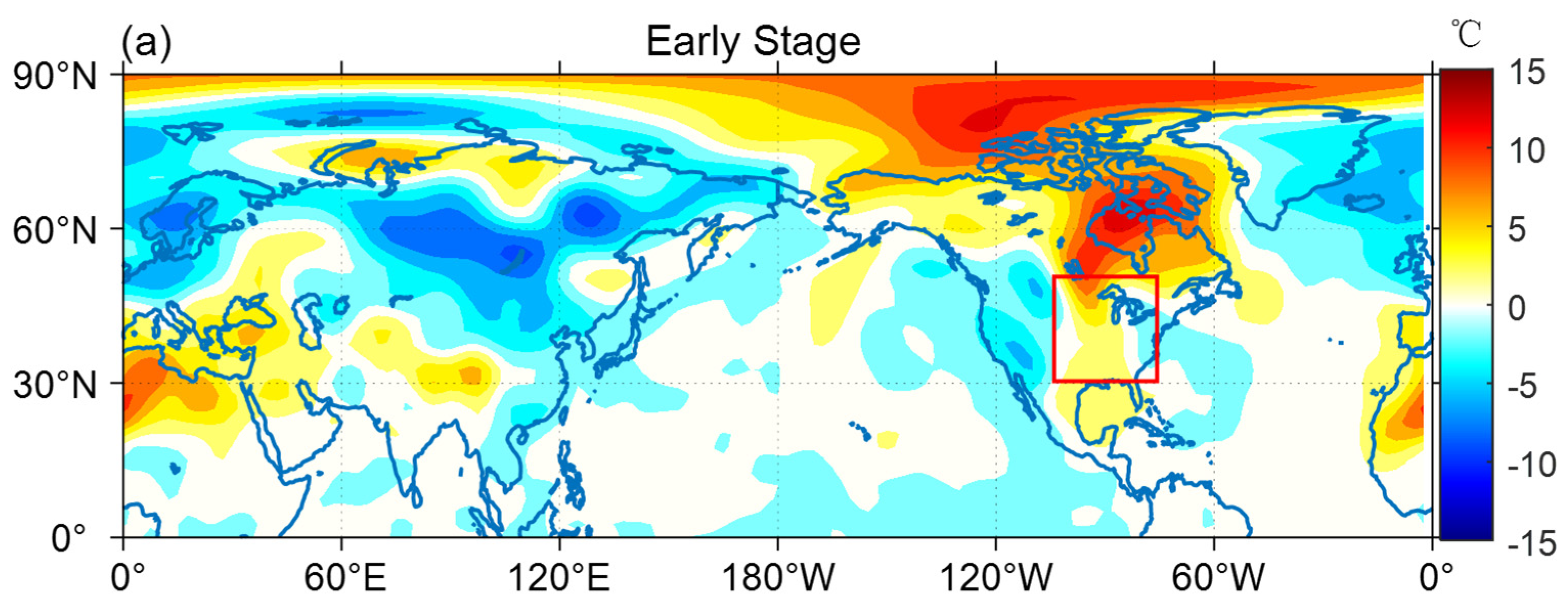
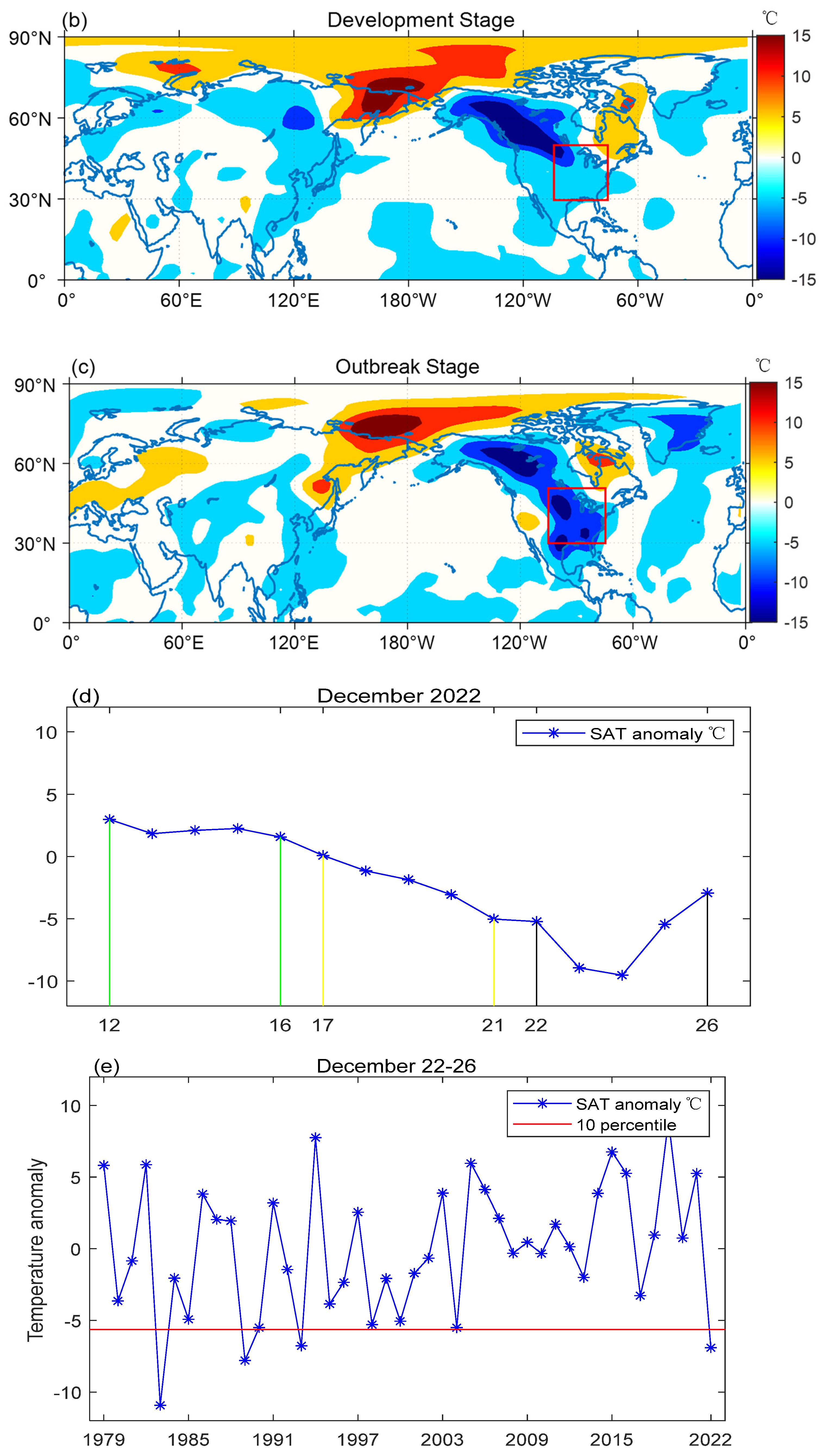
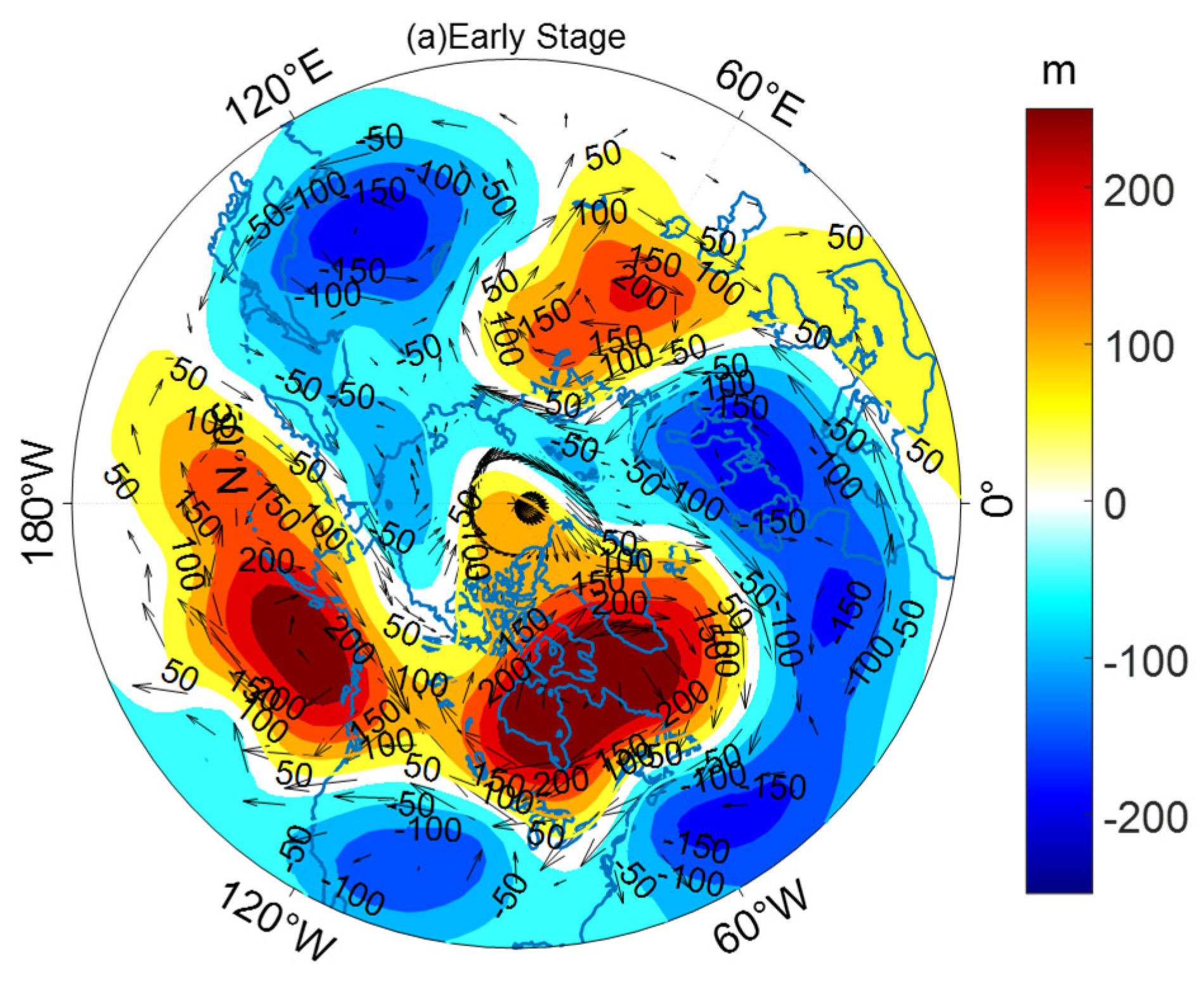


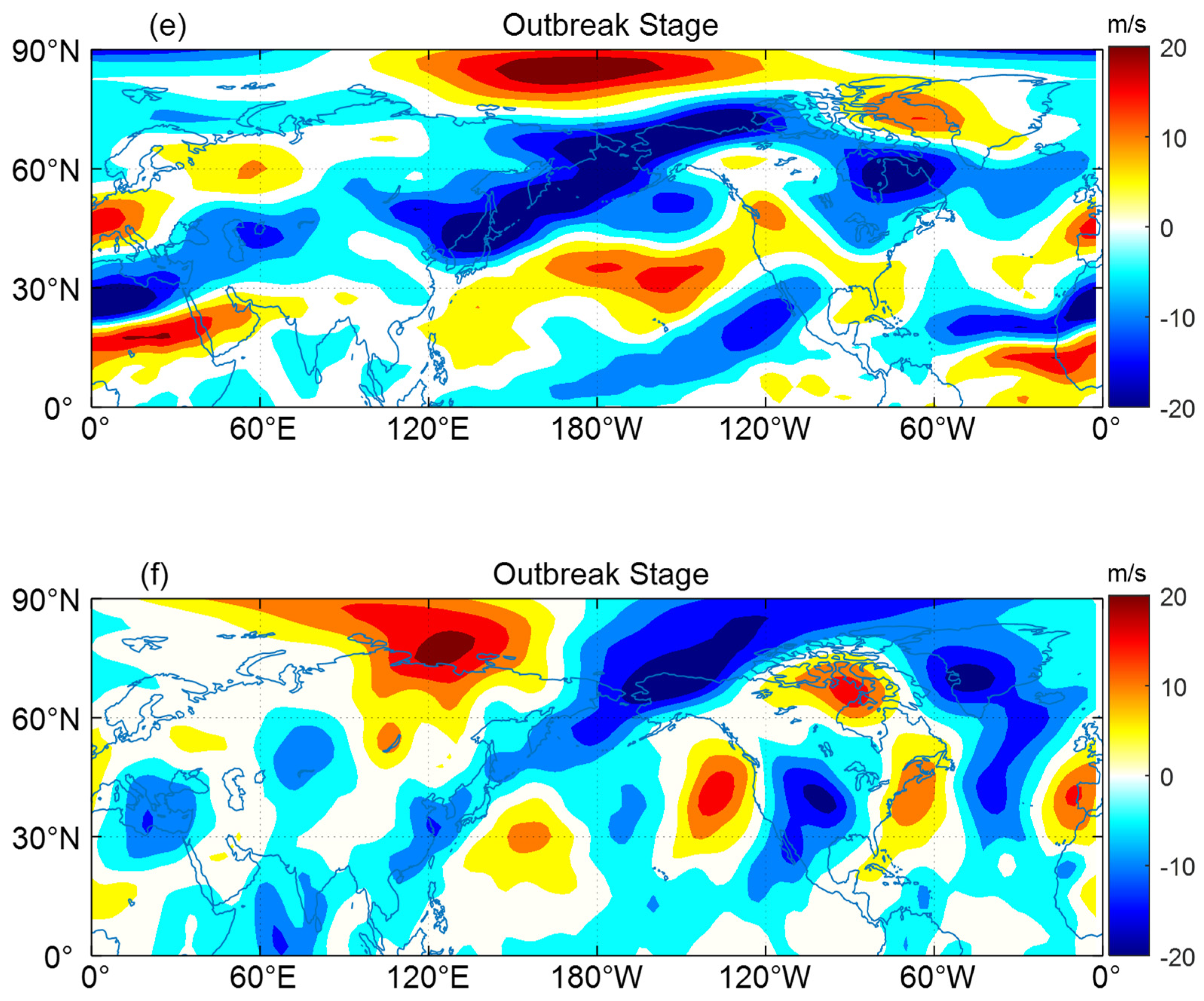



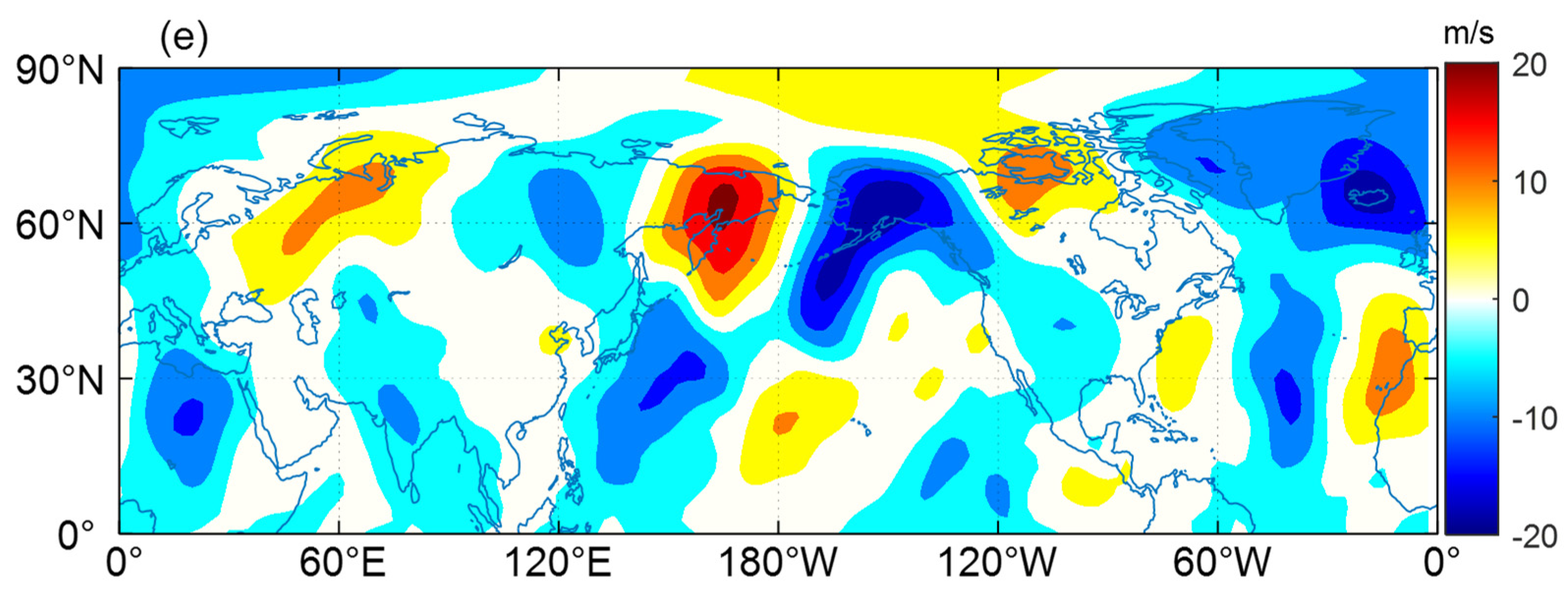
| Cold Event | SAT (°C) | Archipelagic High Pressure (m) | Alaskan High Pressure (m) | American Low Pressure (m) | U-Wind (m/s) | V-Wind (m/s) |
|---|---|---|---|---|---|---|
| 2022.12 | −9.16 | 399.45 | 437.44 | −170.01 | −21.18 | −17.26 |
| 2024.1 | −9.50 | 310.49 | 389.30 | −151.35 | −18.21 | −5.27 |
Disclaimer/Publisher’s Note: The statements, opinions and data contained in all publications are solely those of the individual author(s) and contributor(s) and not of MDPI and/or the editor(s). MDPI and/or the editor(s) disclaim responsibility for any injury to people or property resulting from any ideas, methods, instructions or products referred to in the content. |
© 2024 by the authors. Licensee MDPI, Basel, Switzerland. This article is an open access article distributed under the terms and conditions of the Creative Commons Attribution (CC BY) license (https://creativecommons.org/licenses/by/4.0/).
Share and Cite
Song, Y.; Cui, H.; Xia, C.; Chen, B.; Zhang, Z.; Sun, X.; Gao, C. Analysis of Extreme Cold Events of December 2022 and January 2024 in the United States. Atmosphere 2024, 15, 893. https://doi.org/10.3390/atmos15080893
Song Y, Cui H, Xia C, Chen B, Zhang Z, Sun X, Gao C. Analysis of Extreme Cold Events of December 2022 and January 2024 in the United States. Atmosphere. 2024; 15(8):893. https://doi.org/10.3390/atmos15080893
Chicago/Turabian StyleSong, Yang, Hongyan Cui, Changshui Xia, Baoxu Chen, Ziqun Zhang, Xiaohui Sun, and Chang Gao. 2024. "Analysis of Extreme Cold Events of December 2022 and January 2024 in the United States" Atmosphere 15, no. 8: 893. https://doi.org/10.3390/atmos15080893





